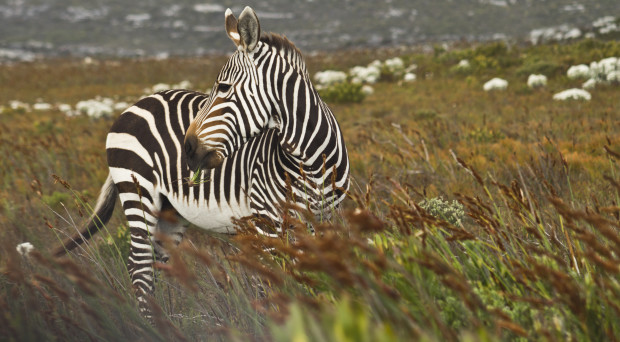
Julia Spaet from the Red Sea Research Center, Saudi Arabia, works on integrating a range of mutually supportive approaches, such as long-line and underwater video surveys, behavioral ecology, fish market surveys and genetic analyses, to better understand and conserve shark populations worldwide.
Yet here she captures one of the rarest mammals on dry land, a completely different ecosystem to the one she is used to studying.
Having been fascinated by sharks at a very young age, Julia Spaet is interested in the ecology and conservation of top predators in marine ecosystems. In July 2010, she began her PhD and during her thesis research, she investigated patterns of diversity, abundance, movements and fisheries in Saudi Arabian Red Sea shark populations.
So how did Julia snap this beautiful image of a peaceful zebra grazing in South Africa? Her answers below explain more.
Could you tell us more about this image?
This is a picture of a grazing cape mountain zebra (Equus zebra zebra). The Cape mountain zebra is the smallest subspecies of zebra and occurs in limited mountainous regions of the Western and Eastern Cape provinces of South Africa.
It was once regarded as a separate species from Hartmann’s mountain zebra, but in the light of genomic evidence the two populations now are regarded as subspecies of Equus zebra. The Cape mountain zebra, though never locally numerous, formerly inhabited all the mountain ranges of the southern Cape Province of South Africa.
By 1922, however, only 400 were believed to survive and today it is recognized as one of the rarest mammals in the world.
By 1922, however, only 400 were believed to survive and today it is recognized as one of the rarest mammals in the world. Mountain zebras associate in small groups of two types: family groups and bachelor groups.
A family group comprises a mature stallion and up to about five mares (usually two or three) plus their offspring. Stallions that cannot obtain mares associate loosely in bachelor groups. Members of a family group normally stay together for decades.
Cape Mountain zebra feed mainly on grass, the red grass Themeda triandra and other climax grasses such as finger grass Digitaria eriantha and terpentine grass Cymbopogon plurinodis (shown in the picture) being particularly favored.
Terpentine grass grows in open grassland or open patches in bushveld regions and generally is a poor grazing grass due to the essential oils which give the grass a bitter taste. It contains an essential oil with about 17 ingredients, with piperitol and deltanerolidol being the three most important ones.
For grazing zebras the height of grass is important – they favor grasses between 50 and 150mm in length and will accept grasses of different length as well as forbs and dwarf shrubs only during dry periods when grass is scarce.
What did you find interesting about this scene?
I was intrigued by the way the zebra blended effortlessly into the surrounding landscape. The high grass was hiding the animal but at the same time emphasizing its beauty.
Where was this photograph taken and how did you take it without disturbing the zebra?
The picture was taken at the Cape of Good Hope in South Africa. I held the camera in my hands while carefully approaching the zebra through the high grass.
Despite this photo being taken on land, your research focuses on marine ecology. Does life underwater inspire your photography too? If so, what is your favourite thing to capture?
Photography has always attracted me, but not until I started taking underwater pictures had the spark truly ignited. I love taking pictures of fish and invertebrate species living on coral reefs but my favorite underwater organisms to capture are whale sharks. These gentle giants make it very easy for snorkelers or divers to approach them and their unique pattern of spots turns each picture into a piece of art.
You can find out more about why this image won our competition and view all the winning images in our accompanying editorial.
Comments